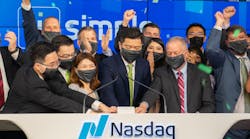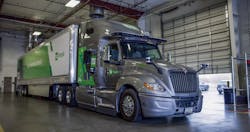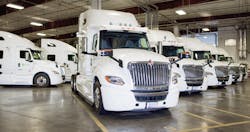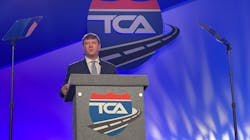With plans to start truly humanless trucking freight runs by the end of this year, self-driving trucking technology startup TuSimple raised more than $1 billion through an initial public offering on April 15 that valued the company at about $8.5 billion.
The San Diego-based company goes public with firm plans in place with Navistar to develop autonomous vehicle (AV) Level 4 trucks by 2024. Driverless tests of the technology will begin in Arizona later this year, Jim Mullen, TuSimple’s chief administrative officer, said during a Zoom interview with FleetOwner the morning after TuSimple executives helped open up trading by ringing the bell at the Nasdaq in New York.
Along with the Navistar production partnership, TuSimple has shipping partnerships already with major for-hire carriers such as UPS, Werner Enterprises and Schneider, among others. The self-driving companies have set their sights on the long-haul trucking industry as the most viable path toward Level 4 (L4) autonomous driving because of its hub-to-hub approach to moving that freight that mostly travels along the U.S’s divided interstate highway system.
TuSimple, which was founded in 2014, is trading on Nasdaq under the ticker TSP. It debuted at $40 per share. It closed Friday, April 16 — its first full day of trading — at $39.95. The company, which is yet to turn a profit on the nascent technology, plans to use its new capital to expand its staffing and rev up the development of its self-driving trucks, which Mullen said will not only help trucking combat its growing driver shortage but will help make U.S. highways safer. Mullen, a former acting administrator of the Federal Motor Carrier Safety Administration (FMCSA), was hired by TuSimple in 2020.
The interview with Mullen has been edited for clarity and length.
FleetOwner: What changes for TuSimple now that you’ve gone public?
Jim Mullen: The valuation of $8.5 billion with a $1.2 billion IPO with really premier investors investing substantial sums of money is a testament to where TuSimple’s been and the product they’ve already developed. And it’s a huge vote of confidence that we’ll get the Level 4 truck on the road in 2024 when Navistar’s purpose-built truck comes off the assembly line.
We’re going to take a big chunk of that money and invest in human resources. With the half-billion dollars we already had on our balance sheet plus billion-plus dollars from the IPO, we’ll have enough cash on hand to get us through 2024. In the meantime, we’re going to go retain the best and brightest talent and make sure we keep on track with our milestones.
Speaking of milestones, we’re going to have a pilot program in Q4 this year where we take the human out and have a fully autonomous truck running about 110 miles depot-to-depot in Arizona.
FO: What are some details of that human-less pilot program in Arizona?
JM: This will be the first time we’ve taken a safety driver out of the truck. It will be on highway and surface streets, hauling actual freight. It’s depot-to-depot, from Tucson to Casa Grande, which is 110 miles. We’ll navigate the surface roads that go onto the interstate. We’ve been doing surface road driving for a couple of years now. We do unprotected left-hand turns in town. We go over railroad crossings.
What we’re predominantly working on now is the edge cases: where you have other motorists that are not conforming with the rules of the road and how do you account for that and how do you make sure you can avoid bad events that aren’t even our fault. Our truck now does a tremendous job of doing what it’s supposed to do, such as following the rules of the road, staying in its lane. The last touches, so to speak, is how does the truck react to somebody on the road not doing what they’re supposed to do?
FO: According to TuSimple’s SEC filings, the company lost about $178 million last year while reporting just $1.8 million in revenue. Is the company’s plan to continue to operate without much revenue until those Navistar trucks roll out in 2024? How does the IPO set you up for that?
JM: That’s exactly right. The cash on hand and the cash from the IPO, according to our projections will get us through that 2024 time period. That was the goal of the equity raise all along. Obviously, we're very pleased we were able to be valued where we were and trade where we are. In fact, you may have noticed we're trading above the range on the prospectus, which was $35 to $39. Due to robust demand, we’re trading above prospectus at $40 a share.
FO: How has TuSimple’s autonomous technology improved to deal with inclement weather? Are there any plans to expand beyond the Southwestern U.S.?
JM: The system works very well in rain. So as it relates to inclement weather, rain is not a problem. Our cameras see very well in the rain. Lidar doesn’t work as well in the rain as it does in dry conditions, but cameras do. So we can operate in the rain with no problems. Snow is still a challenge — that’s a few years or so away. On the algorithms, we’re still working on that.
Right now, we’re running in Arizona, Texas and New Mexico, which is Phase 1. During Phase 2, we’ll go East. We intend to be running from Dallas to North Carolina and Atlanta by the end of 2021. For Phase 3, we hope to be running from coast to coast: from California to Florida along I-10 and other arteries. Further north is to be determined. We’re not doing anything in conditions where we might encounter snow until we’ve perfected that.
So we’re focusing in the near term entirely in that southern corridor. Candidly, the freight market and the volumes in that area are robust enough that that’s plenty for us to work on for the next five years-plus.
FO: How do fleets need to prepare for the maintenance of self-driving trucks?
JM: The whole purpose behind these purpose-built autonomous trucks is for reliability. Aftermarket autonomous add-ons are not as reliable. So we continue to work with Navistar on what that build-out looks like with the sensor suite. Once we get the purpose-built truck out, we anticipate that the maintenance and maintenance staff to be really similar to what it is today.
FO: Moving beyond the manufacturing side partnerships with Navistar and Traton, TuSimple has some early buy-in from major U.S. fleets such as UPS, Schneider, Werner and U.S. Xpress. How have these early partnerships helped TuSimple’s development and what role with these fleets play in the near future?
JM: They’re going to be instrumental. We’re really good at developing the artificial intelligence to operate a truck but we’re not a trucking company. If you look at our 100-plus employees, you can probably count on two hands the number of folks that have actual trucking experience. So our relationship and our strategic partnership with Werners, the UPSes of the world, are going to be invaluable. We have a handful of trucking folks on our advisory board.
FO: Is the current U.S. infrastructure ready for Level 4 and Level 5 autonomous trucking? Will infrastructure improvements be needed to help self-driving trucks become more prevalent?
JM: Two questions: Do we need better infrastructure? Heck yeah. But not for our autonomous trucks. Level 4 trucks can operate in the current infrastructure environment. In the current infrastructure package before Congress, we don’t have any serious asks. Like any trucking company, we’d like to see better infrastructure but nothing that we need right now to operate our L4 trucks.
FO: Will real-world adoption be rolled out on a lane-by-lane basis?
JM: It will be lane-by-lane. It takes about two weeks to create our high-definition maps, which are like virtual railroad tracks, from depot to depot. The customers will dictate where those maps are. We’re already working on a list with our strategic partners and customers.
Coming from trucking, a lot of these motor carriers treat their network as their secret sauce and they guard it like crazy. But many of them have already given us their network. We’re working with them so that when 2024 rolls around, it’ll be plug-and-play. We’ll just take the Navistar AV truck and plug it into the existing manual truck route.
FO: Who will make the determinations that the technology is safe to launch — the OEMs, the customers, the FMCSA?
JM: Right now the regulatory landscape is very positive, very favorable for AV trucking and there are no gating criteria neither at the federal nor the state level. We work hand-in-glove with the government, both NHTSA and FMCSA and the state regulators. We won’t do it unless we’re absolutely certain that it’s safe. We’ll continue to work with legislators, regulators, law enforcement as we go lane-by-lane.
FO: Do you expect TuSimple to lead the way and the government will follow will regulations for AV trucking? Or are anticipating the government to come down pre-regulate the space?
JM: We're not expecting the government to set up prescriptive gating criteria on this. What the government has been doing for five-plus years has been very deliberate in its strategy to make sure there are not unnecessary regulatory barriers to permit the safe proliferation of autonomous trucking.
There are some regulatory provisions from the FMCSA, which contemplate humans doing tasks other than driving and how do you address those — such as talking to law enforcement, deploying emergency warning triangles if your truck is disabled, and cargo securement. The FMCSA has started the rulemaking process and how those regulatory provisions can be addressed with an autonomous operation.
In the meantime, while the government does what it does, we’re working on our solutions for those problems. For instance, when it comes to cargo securement, we could use weight sensors and cameras to make sure there hasn’t been any movement of the cargo. As it relates to triangles, we could deploy a drone from the trailer, we can remotely drop flares. We’re working on solutions to these issues as the government works through its process.
FO: How do you anticipate the public acceptance of 80,000-lb. vehicles rolling down the highway without any humans on board?
JM: That’s obviously an issue that we and our competitors are confronting and will continue to confront. It’s really incumbent upon us — and our competitors — as we continue to accumulate more miles and as the AI improves and advances, that we educate the general public. Because the safety benefits are going to be substantial with autonomous trucks. About 90%-plus of the accidents on the highway involving large trucks are due to human error — whether it's driver fatigue, driver impairment, what have you.
Truck drivers are the backbone of our country and our system is going to complement the human driver. If you think about all the safety benefits and how we’re going to help solve the driver shortage, which is very real.
So along with the driver shortage solution and roadway safety solution, our truck is greener. Our AV miles get about 10% more miles per gallon than manually-driven trucks. It’s incumbent upon us to make all that known — and I think society will come around to the concept of 80,000-lb. driverless vehicles on the interstate.
FO: How will this technology complement the human driver?
JM: Geographically, we believe this is just going to be in certain parts of the country for the foreseeable future. As you know, the middle-mile — that long-haul middle mile — is the hardest job to fill in trucking right now. We’ll fill that void for our strategic partners for their supply chain. That, in turn, will help fill jobs in the first and final mile driving space. The net effect on trucking jobs will probably be about neutral — or slightly up.
We don’t think this is going to be a large displacement of labor. It might change the job that they have today. But most estimates show a 60,000 driver shortage that will grow to over 100,000 in a couple of years. The median truck driver age is 47, which is five years older than the median age of the U.S. workforce. As that driver shortage continues to increase — unfortunately — our L4 truck is the absolute solution for that.
FO: There have been more changes in trucking and logistics over the past decade than possibly during any point in the industry’s 100-year history. Do you envision that change accelerating even more in the coming years? And what is your and TuSimple’s vision of what the trucking industry looks like in 2031, 10 years from today?
JM: The last decade or so has seen probably as much change as any since deregulation. Our technology — and AV technology in general — between safety and the driver shortage itself is going to be a game-changer.
When you think of, on average 5,000 fatalities annually for the last decade, caused by large truck crashes. That will go down dramatically. Then look at the driver shortage and what you see in the industry with an extremely tight driver market that might be as tight now as it’s been in a couple of decades. Unfortunately, that means that some folks hire and retain drivers they otherwise might not.
If you replace just 5% of human-driven trucks with L4 trucks, that helps make sure you have the safest drivers on the road. It’s going to be a game-changer in that regard. If you look at the people who are seriously looking at our technology, their companies have been very tech-progressive in the past and I think that’s a good measuring stick for what to see in the future. So we’re really excited about the people we have on board with our motor carrier shipping partners. We’re going to be expanding that and we firmly believe this is going to change the supply chain.







